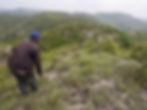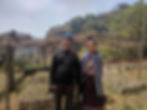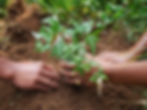Restoring Khasi Hills, India
- Natalie Harvey
- Dec 19, 2019
- 11 min read
A look into the successes of the Khasi Hills project. As of 2019 TreeSisters no longer funds this project, but we would like to thank everyone who helped fund this amazing project!

Treesisters began funding the restoration of tropical and subtropical, mixed broad-leaved forests, including montane cloud forests in the Khasi Hills, in October 2017. The project is led by WeForest, one of our valued reforestation partners. Khasi Hills form part of central Meghalaya, a land-locked state in northeastern India and bounded to the south by Bangladesh. Like Scotland, Meghalaya is a region of scenic hills with cultivated terraces. The restoration sites are in the East Khasi Hills and the North Khasi Hills (Ri Bhoi) districts. 75% of the Khasi Hills is covered with luxuriant dense tropical forests of altitudes and degraded forests with more open tree canopy, which covers approximately 5,500 square kilometres (1), approximately the size of the built urban area of Greater Sidney, Australia.

WeForest supports the Khasi tribes through the partnership with the Ka Synjuk Ki Hima Arliang Mawphlang Welfare Society. The "Federation" gathers forest dwellers spreading across 11 indigenous governments and 75 Khasi villages. The Federation seeks to release pressures off their remaining forests with forest restoration, community engagement, forest monitoring and research data collection. The project holds the possibility to regenerate over 4 million trees spanning across 5,000 Hectares - about the size of Washington's Dulles Airport, USA. It represents 1% of the Khasi Hills landmass and provides vital protection for knowledge, wildlife and water sources. This project is highly important to TreeSisters and WeForest, because of the Khasi's deep cultural and traditional attachment to and respect for forests.
WeForest supports the Khasi tribes through the partnership with the Ka Synjuk Ki Hima Arliang Mawphlang Welfare Society. The "Federation" gathers forest dwellers spreading across 11 indigenous governments and 75 Khasi villages. The Federation seeks to release pressures off their remaining forests with forest.
Forest description

The Khasi Hills is certainly one of the most picturesque places in Meghalaya. It is a complex landform of rolling uplands, rounded hills, steep slopes and deep valleys. (Map of Meghalaya. Source: Sadiq, M. et al. 2014. REE mineralization in the carbonatites of the Sung Valley Ultramafic-Alkaline-Carbonatite Complex, Meghalaya, India. Central European Journal of Geosciences. 6: 457-475.)
Climate
The Khasi Hills are one of the wettest places in Asia. 'Meghalaya' translates to 'the abode of clouds' in Hindi and Sanskrit. Because of their high altitudes, forests literally "meet the clouds", which explains why they are called 'cloud forests'. They even live up to their name to the point of hitting rainfall records. Heavy rainfall contributes substantially to the river flow, essential to the Ganges-Brahmaputra-Meghna river basin, which Indi and Bengal depend upon greatly.
Forest State

Forests cover about 75% of the Khasi Hills, with east Khasi and west Khasi, respectively, covered at 63% and 75%. This is impressive compared to England's green and pleasant lands, which only include 10% forest cover. The largest forest blocks are located in the northeastern part of the Khasi Hills. Forests vary from tropical moist deciduous (generally low elevations below 1,200 meters and lower annual rainfall) to fragments of subtropical evergreen (cloud) forests, or subtropical semi-evergreen forests, persisting as sacred groves or confined to gullies, steep slopes, depending on the altitude and location. Forests found above 1,000 meters are a mix of broad-leaved and needle-leaved trees. Subtropical pine forests above 1,200m have been planted as secondary forests (not climax forests).
Plant & Tree Variety
Arising from a diverse topography and climatic conditions, the Khasi Hills are home to a luxuriant variety of plants, some of them only be found in this area, such as pitcher plant Nepenthes khasiana, an insectivorous endemic plant in threat of disappearing due to habitat loss. The Khasi Hills alone are endowed with 75 orchid genera, represented by 265 species. These hills are also considered the centre of diversity for several primitive tree genera, such as Magnolia and for families, such as Elaeocarpaceae.
Sacred Groves

The Mawphlang Sacred Forest is one of the most famous sacred groves in the Khasi Hills. The Khasi people value their forest for their role in protecting springs and stream beds and conserving wildlife. They house ancient stone monoliths and are linked to similar traditions across India and can be found all around the world. The Khasi people attach a spiritual significance to areas of forest identified as sacred forests.
Wildlife
According to WWF, over 110 large mammals are found, such as the endangered tiger (Panthera tigris) or clouded leopard (Pardofelis nebulosa). Moreover, most bird life is only found here or restricted to South Asia.
Indigenous Caretakers
The Meghalaya is not only a high biological and ecological value forest, but it is also inhabited by outstanding indigenous tribes with high social or cultural values, namely the Khasi tribe, who are the most represented, as well as the Jaintia and the Garo tribes. Traditionally property and the tribal office are passed down through the female line, mother to the youngest daughter, though the management has been in the hands of the men and increased conversion to Christianity impacts these traditions. These tribes have been governing the forest lands held by centuries-old, traditional forest management systems. The Meghalaya tribe's traditional cultivation ways include shifting agriculture ('slash and burn') (3) in and around forests and terrace cultivation (bun cultivation) in the valleys and foothills in order to improve soil fertility, to conserve soil moisture and prevent and soil erosion.
Drivers of deforestation
The Khasi Hills forests are being intensively degraded and cleared to make room for shifting cultivation and timber extraction by rotational felling and developmental activities. Between 2000 and 2006, forest loss exceeded 5% per year (4) in East Khasi Hills. Today, one-third of the Khasi hills area is found barren and shrubby, also used to grow crops, mostly appearing in brown tones on GoogleMaps.
Old Growth and Secondary Growth Forests
Broad-leaved forests represent the original primary vegetation of the region. Still, today they are only present in small pockets confined to gullies, steep slopes and ten sacred forests/groves (set up for religious purposes). Nowadays, pine forests and grasslands dominate the landscape. They are signs of past deforestation or forest degradation. They are called "secondary-growth forests" because they regenerate naturally after significant removal or disturbance of the original forest cover.
Development, Population Increase & Agricultural Practices
Forest conversion and forest degradation are due to a complex matrix of reasons, including; ramping demography (especially the Khasi) and tempting economic development, including the 70s-80s timber trade. In the context of the population's rapid increase, (5) Meghalaya's traditional agriculture practices are no longer sustainable for mass production needs. At this scale, shifting cultivation undermines natural forest structure and natural regeneration.

Privatization, Mining & Forest Management
The traditional forest management institutions have recently given way to the privatization of forestland to village individuals. Today, the Khasi are clearing forests for crops, permanently or for a limited period. They are leasing their lands for stone, sand and gravel quarrying, forest logging, and grazing. Quarrying causes soil erosion and landslides of denuded hill slopes. It has been facilitated by a lessening culture and tribal traditions and weakening traditional authorities and institutions. Meghalaya also has deposits of coal, uranium, granite and crystals.
Water shortages, Soil Erosion & Climate Changes
"Traditionally, our ancestors preserved the forest because the forest gave our people everything. But in recent times, we started to take only from the forest and stopped taking care of it. But now it is time to restore the balance". -Tambor Lyngdoh, Head of the Federation and member of the Lyngdoh clan, as provided by WeForest.
Many people within the Khasi tribes are making the connection between deforestation, increasing water shortages, soil erosion and land degradation, as well as changes in microclimates they are now experiencing. Water pollution is also a huge risk due to the absence of sewage systems and manure. Rivers can be polluted with faecal coliform and organic Nitrate from cattle defecating in the rivers. The Khasi know that forests can play a role in absorbing organic nitrates.
Certain Khasi forest dwellers are even afraid of economic development interests and the potential disconnection from Nature and their cultural values.
Communities Working Together
When demographic and economic pressures are threatening their ancestral forest heritage, especially the forested areas near water bodies which are considered sacred, the Khasi have to gather together and replant trees. In 2011, the Khasi created a watershed-level Federation to control deforestation, mostly around the issue of water quality and availability. Supported by Community Forestry International (CFI) since 2010, the Khasi have designed a framework to slow down and stop the loss of communal forests, which involves forest conservation - and a bit of restoration, namely "the Khasi Hills Community REDD Project" under the Plan Vivo Standard. The project is nowadays closed. The Khasi communities then partnered with WeForest to restore degraded land. Let's see what motivates them and how it works.
Who are the Khasi Hills tribes?

The Khasi are rural. They are nearly self-sufficient as Nature fulfils their essential needs. They rely on locally-grown fresh fruits and vegetables, plant-based medicinal and freshwater products procured by their forest garden or home gardens, and collected and gathered from nearby natural forests. Some of their drinking water comes from tap water, and some from untreated sources. Some are fetched from wells or directly procured from the springs after a long-distance walk. While many Khasi villages are remote, they are accessible by car even if the road conditions are not always very good.
Sacred monoliths in the forested hills are of cultural significance to the Khasi people.
Khasi Faith & Practices
In Khasi society, faith and culture are highly connected with Nature. To them, the natural world is indeed a sacred web of life. Many Khasi traditional dances and rituals demonstrate their intrinsic ecological connection. For the last 500 years, the Khasi have been protecting sacred forests and ancient stone megaliths set apart for cultural and religious purposes.
A Forest Culture
The majority of them are engaged in occupations related to the utilization of forests. Village forests provide villagers with firewood, edible plants, and wood materials for house construction and repair. (7) In particular, Khasi people practice age-old intercropping/agroforestry, (8) with trees considered a primary source of cash income. They might be cultivating economically useful trees in a natural forest (4) (e.g. betel leaf cultivation in the forest).
Age-Old Forest Management
The Khasi nurture forests and trees in the proximity of their habitations, water sources and on steep slopes. To them, forests are ancestral bounties to be passed to the next generations. As a result, they have been practising "age-old forest management", and forest conservation occurs in the vicinity of their habitations, near water sources (sacred groves), on steep slopes with Bun cultivation. They have been rationalizing tree logging and sharing revenues among all community members in clan forests, village-restricted forests, etc.
Society Governance

Most of the forests in the Khasi Hills are governed by autonomous councils called the 'Dhurbars', responsible for small administrative units known as 'Hima' (kingdoms/village clusters). Dhurbars are essentially the general meeting of the clan/kingdom. In practice, the forests in the Khasi Hills are essentially governed and managed by clans, individuals, groups or traditional institutions under customary rules. Durbars are traditionally only formed by males. However, Natural Resource Management Plans are developed for each village cluster by a specialized group called the Lower Working Committee (LWC), initiated by the CFI project earlier introduced, which is formed with 50% women and 50% men. The CFI project has greatly benefited the Federation and LWC with important capacity building and community engagement. In particular, they were trained to measure forests.
Project description
What were the expected outcomes?
The project seeked to restore 5,000 more hectares of degraded forest lands towards reaching 833 trees per Hectare, which is the tree density of the nearby natural forests, in order to tackle poverty and reduce pressure off the Khasi forests. The project also contributes to protecting watersheds and improving water availability and quality. To limit grazing, the project creates forest-based livelihood opportunities through raising awareness and capacity-building events, tree nursery development, and other activities, such as poultry, piggery, and tailoring.
What is the restoration method?
Under this project, the forest restoration involved is called "assisting natural regeneration". It essentially protects wild regenerating tree saplings of over 40 species of trees, but the project also plants 10% of trees per year to increase species diversity. Sites are selected when assisted natural regeneration is possible through technical feasibility developed by WeForest.
Which trees are they planting?

Among the 40 species of trees involved are: Alnus nepalensis, a pioneer (tree often colonizing clearings), nitrogen-fixing tree, which is native to the subtropical highlands of the Himalayas. The project is also planting endangered tree species, such as the critically endangered Ilex Khasiana, which is endemic to India.
Who owns the land?
The restoration work is organized in several scattered plots across the Khasi Hills in the South and North of Shillong (the capital of Meghalaya), on newly degraded areas (in different plots than the 'Khasi Hills Community REDD' former project). These are lands held by the Khasi communities, clans, families, or even Sacred Forest (set apart for religious purposes), and surrounding water catchments.
What's the restoration site like?
Under this project, Khasi communities are restoring degraded mixed broadleaved forests and some forest plots where mostly pines are growing. The starting density at the restoration sites varies between 300 and 600 trees per Hectare (degraded forestlands). Fragments of mixed evergreen cloud forests remain in the project area as sacred groves.
How does it benefit the locals?
The project does not generate revenues from paying (back) the Khasi for ecosystem services, such as in the 'Khasi Hills Community REDD project' mentioned above.

The Khasi directly benefit through restored landscapes, employment and additional livelihoods, increased soil fertility under agroforestry systems, and indirectly, in the long run, through replenishing water tables and drinking water. Interestingly, WeForest has been working with other partners to strengthen the communities' capacity to monitor forest-water interactions. Indeed, tackling water scarcity in the dry months and pollution has been stated as the top priority by many community members.
Who's involved?
The Federation is responsible for the project implementation. They facilitate and organize the field work and events with individuals, Self-Help Groups, Farmer's clubs and LWCs.
Khasi participating villages are employed to operate tree nurseries and do the forest restoration work. This is done by individuals, Self-Help Groups (9) and farmers' clubs. Villagers are actively involved in designating forest management sites and the best intervention approach (tree species, silvicultural approach).
WeForest is responsible for project coordination and reporting to TreeSisters. They are also engaged in capacity building and research to enhance silviculture practices, water quality, and availability. We Forest also organises training on sustainable agriculture, including agroforestry, forestry conservation and protection. LWC's Forest Management Plans are solely financed under the REDD project (it is not part of our project's budget).
What is the place of women?

The distinctive Khasi society is matrilineal (the youngest daughter inherits) and matrilocal (the husband lives with his spouse's family). Because of that, women are primary business holders and entrepreneurs. As a result, they largely benefit from the training and awareness programs, and 75% of the Self-Help Groups engaged in livelihood activities (including ecotourism initiatives, animal husbandry, food establishments and tree nurseries) are run by women. While women are not involved in community decisions because they have been traditionally barred from taking part in decision-making, (10) the project makes sure they participate in the Dhurbar's consultation meetings regarding decisions about the forest.
And thanks to the project, women hold an increasing stake in forest restoration and management, today forming half of the LWC elaborating the Forest Management Plans. Since the Summer of 2017, the project also employs female community facilitators as promoters of natural resource management. They also serve as managers in the respective villages to keep the restoration activities running and create a bridge between socio-economics and forestry.
What will happen next?

The Khasi will continue to manage their forest resources long-term - with trees and forests continuing to drive their culture and livelihoods. This is possible because the project encourages forest-based entrepreneurship. Self-Help Groups, farmers clubs and micro enterprises are trained to set up, manage and operate tree nurseries and small horticulture businesses (including the cultivation of plums, peaches & others under agroforestry systems).
History and Future of this project
2017 - The project partnership agreement was signed on October 1st, 2017.
2018 - Self-Help Group Award held in January 2018 celebrated the best-performing Self-Help Groups. The Khasi Hills Federation recently recognized the best performance and most creative work of the Self-Help Groups engaged in forest restoration and sustainable livelihood activities, acknowledging the success of 75% of women groups!
Through the restoration of 22 sites (varying in size from 7 to 232 hectares), TreeSisters directly restored 94,173 trees over 127 ha in May 2018, the equivalent of around 177 soccer fields. This will eventually, after 20 years, lead to 21,596 tons of CO2 stored or the equivalent of the annual carbon footprint of 2,200 Europeans.
2019 - Our portion of this project was completed in December 2019.
Please support our projects.
If you would like to support this project and our other planting projects around the world, please join Treesisters as a monthly member. Every contribution makes a difference.



